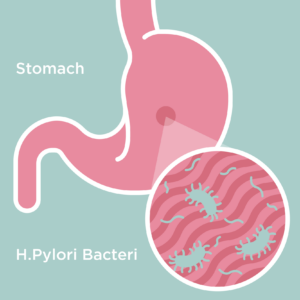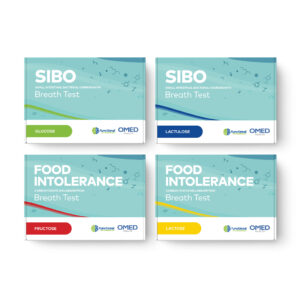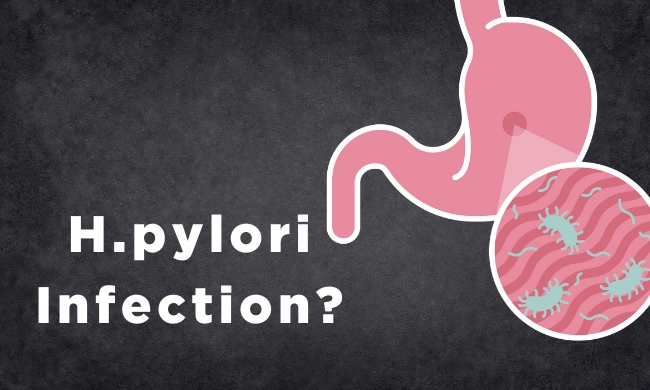Our hydrogen and methane breath tests (HMBTs) kits are designed to aid in the at-home diagnosis and monitoring of gastrointestinal conditions such as small intestinal bacterial overgrowth (SIBO), and carbohydrate malabsorption (CM), but did you know there are other well-established breath tests for other conditions already in routine use, such as H. Pylori breath tests?
At-home Helicobacter pylori breath tests
The H. Pylori breath tests are used to detect a particular bacterial infection of the stomach that can cause ulcers, leading to symptoms such as burning pain in your stomach, bloating, weight loss, frequent belching, nausea, and a loss of appetite. The presence of this bacteria in the stomach can also lead to more serious issues such as cancer. In fact, this bacterial infection has been shown through scientific studies to be the strongest risk factor for the development of stomach cancer. H. pylori symptoms include stomach pain, nausea, and a loss of appetite.

The specific type of bacteria identified in this breath test is Helicobacter pylori (H. Pylori), which is commonly found in the stomach. A systematic review in 2018 estimated that 50% of people across the globe on average have H. Pylori in their stomachs. In most people, H. pylori causes no illness or symptoms. However, approximately 17% of people with H. pylori in their stomach will go on to develop an ulcer (1), and between 1 – 3% of people may develop gastric cancer (2), therefore it is important to test whether you have an H. pylori infection if you are experiencing symptoms.
During the test, a substrate solution containing 13 Carbon Urea (13C-Urea) is ingested, and a sample of breath is collected 30 minutes afterward. Unlike the cells of your stomach, H. pylori can convert urea into ammonia and carbon dioxide which can be measured on breath to test for infection. The treatment of an H. pylori infection is often a combination of at least two different types of antibiotics to ensure that the infection is completely cleared. If there were ulcers present in the stomach usually a medicine such as a proton-pump inhibitor (PPI) is also prescribed to reduce the amount of stomach acid, allowing the ulcers to heal better. the ulcers to heal better.
The H. pylori breath tests are considered to be one of the gold standard diagnostic tools, due to its high accuracy. The urea breath tests consistently perform better when compared to other available tests for H. pylori (3), which include a stool test, a blood test, and a physical biopsy of ulcers in the stomach. However, these alternative tests are not as tolerable for patients as a breath test – especially considering tissue biopsies that would be gained through an endoscopic procedure.
There are situations where a combination of different H. pylori tests are recommended to be used to complement the shortfalls and strengths of each test to optimize diagnostic performance in a variety of clinical situations. The urea breath test for H. pylori has a strong position in current gastroenterology departments and is already proving to be very clinically useful as a non-invasive alternative to other diagnostic and monitoring tools.

Having more at home breath tests available for a wider number of conditions for easy diagnosis and ongoing monitoring can transform healthcare, especially for those suffering with gastrointestinal symptoms. Long-term sufferers with their gut health know the frustrating and long struggle of suffering often for many years without clear answers, treatment options, or any method of measuring success.
If you are one these sufferers, we offer HMBTs that can be used to help in the diagnosis of small intestinal bacterial overgrowth (SIBO) and/or food intolerances, alongside further advice from gastrointestinal experts. Hydrogen and methane are produced by the community of microbes that live in your gut, known as the microbiota, or the microbiome. Characteristic changes in the level of these gases over time after ingestion of a test substance (such as lactulose) can indicate the presence of “unbalanced” microbiome, and treatments such as antibiotics or diet changes can be recommended.
Currently home-based breath testing kits for SIBO and food intolerances are only available to people in the UK and can be purchased for £250. To find out more about what each test does, visit our FAQs page.
Our at-home device the OMED Health Breath Analyzer that measures hydrogen and methane anytime, anywhere will be launching later this year. Paired with the OMED Health App, this allows you to monitor your microbiome on the go, as well as track lifestyle factors such as sleep, diet, and exercise over time. This can help you to pinpoint exactly what is causing your gut health problems and give you back control. Join the waitlist today to get the latest updates.
References
- Malaty HM. Epidemiology of Helicobacter pylori infection. Best Pract Res Clin Gastroenterol. 2007;21(2):205–14. DOI: 10.1016/j.bpg.2006.10.005
- Cancer Research UK [Internet]. 2019 [cited 2023 Jul 24]. Does H.pylori cause cancer? Available from: https://www.cancerresearchuk.org/about-cancer/causes-of-cancer/infections-eg-hpv-and-cancer/does-hpylori-cause-cancer
- Patel SK, Pratap CB, Jain AK, Gulati AK, Nath G. Diagnosis of Helicobacter pylori: What should be the gold standard? World J Gastroenterol. 2014 Sep 28;20(36):12847–59. DOI: 10.3748/wjg.v20.i36.12847
- Zamani M, Ebrahimtabar F, Zamani V, Miller WH, Alizadeh-Navaei R, Shokri-Shirvani J, et al. Systematic review with meta-analysis: the worldwide prevalence of Helicobacter pylori infection. Aliment Pharmacol Ther. 2018 Apr;47(7):868–76. DOI: 10.1111/apt.14561
- Warren JR, Marshall B. Unidentified curved bacilli on gastric epithelium in active chronic gastritis. The Lancet. 1983 Jun 4;321(8336):1273–5. DOI: 10.1016/s0140-6736(84)91816-6



